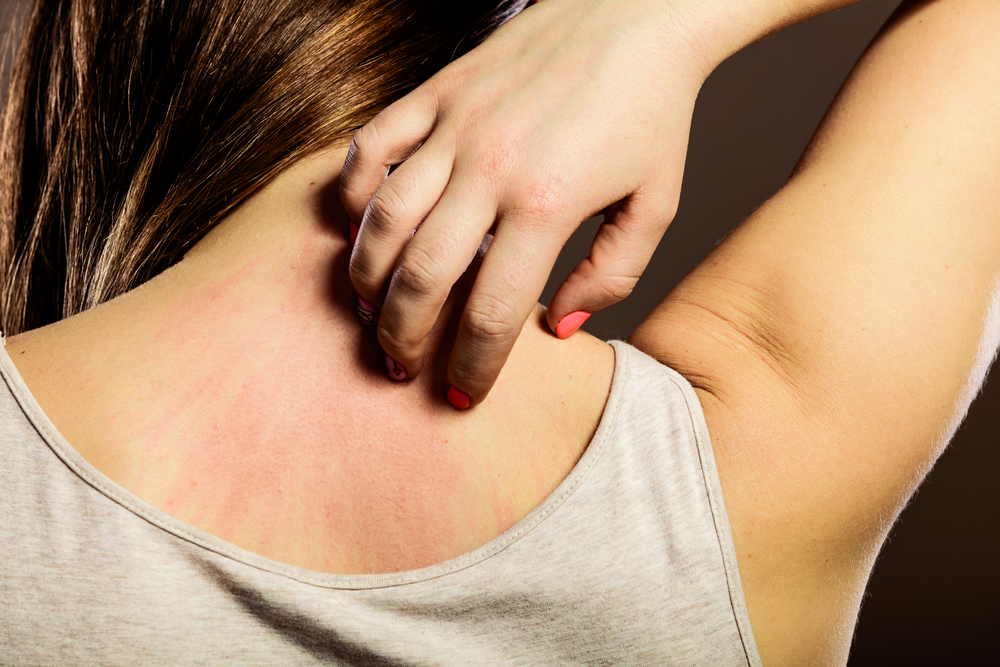
Skin Allergy: Symptoms, Causes and Treatment
Skin Allergy: Symptoms, Causes and Treatment
A wide range of causes might contribute to irritated skin. Immune system diseases, drugs, and infections are just a few examples of what you can experience. An allergic skin condition is one in which an allergen is the cause of the immune system's reaction. Typically harmless substances like wool, pollen, soap, or plants may cause a skin allergy. When this trigger is found, the immune system goes after it to get rid of it. The result is a rash on the skin that is red and itchy. Atopic dermatitis, contact dermatitis, and hives are all types of skin allergies.
Symptoms
An allergic skin response is itchy, red, or blistered skin. All the following symptoms may be present: itching, a raised bump, redness, or a combination of the three.
- Rash
- Itching
- Redness
- Swelling
- Elevated bumps
- Skin that is flaky or scaly
- Cracked Skin
Symptoms and patterns may be used to identify different kinds of skin allergies. Over time, people's reactions might alter. A second exposure to the trigger may result in entirely different symptoms from the first.
Causes of Skin Allergies
It might be difficult to identify the culprit. More than 3,700 possible allergies exist.
These are some of the most common suspects:
Nickel. The most prevalent cause of contact dermatitis is metal in jewellery, belt buckles, zippers, and bra hooks. Make sure you know how to prevent nickel.
Fragrances.
Among the most common triggers are perfumes, lotions, and other scent-enhancing goods. Learn more about scent sensitivities here.
Ingredients are found in everyday home goods and supplies. Preservatives and metals found in common household items might irritate your skin.
- Cleaners
- Sunscreens
- Cosmetics
- It's time to get some new hair colour!
- Antiperspirants
- Tips for skin-friendly housecleaning are available here.
Skin creams containing antibiotics. Many over-the-counter choices include bacitracin and neomycin. Educate yourself on the many medicines that may cause allergic reactions to the skin.
Latex. Natural rubber is used in a wide range of goods, including:
- Condoms
- Balloons
- Gloves that were thrown away
- Feeding bottles
Types of Skin Allergy
Allergic skin disorders have multiple types, each with its distinctive symptoms.
Eczema
This skin allergy type, also known as atopic dermatitis, usually begins in childhood, although it may also emerge in adolescence or adulthood. It is widespread in the flexural regions (behind the knees and elbow creases) in older children, teenagers, and adults; however, it may also appear on the eyebrows, hands and neck. To exaggerate natural skin marks and aberrant pigmentation known as lichenification, scratching and rubbing the skin may harm the skin's health.
Itchy, Red, Swollen Skin
The most typical cause of this response is irritation. However, an allergic reaction might also be to blame. Skin inflammation occurs due to coming into touch with an allergen trigger material.
Even though the rash might seem like eczema, it only appears on skin that has come into touch with the irritant. Affected parts of the body include the skin on the upper and lower lip, eyelids, neck, and extremities. In addition to being allergic to poison ivy, poison oak, poison sumac, and poison oak, the individual is also sensitive to nickel, which may be found in jewellery, cosmetics, medical creams, latex, and chemicals on shoes.
Hives
Haemorrhoids are known medically as urticaria, which is an itchy rash that might be an indication of a severe medical issue. There are a variety of forms and sizes of elevated pink or red pimples with pale centres known as hives. A hive's position, size, and form may vary, and it may or may not itch. Human beings seldom scratch themselves so badly from hives that they injure themselves.
Allergens that may produce hives include:
- Nutritional supplements, such as peanut butter and egg yolks
- Latex
- Medicines like penicillin and sulfamethoxazole, aspirin, and ibuprofen
- Insect stings are also painful.
- Many physical factors might affect the body's physiology.
However, hives are not contagious and may be an early warning sign of a potentially life-threatening allergic reaction requiring epinephrine injection.
Angioedema
Hives are often accompanied by angioedema, a swelling that may affect the lips, eyes, hands, and feet but do not always lead to anaphylaxis. An odd stinging or tingling feeling is what patients with angioedema describe it as.
Diagnosis
To find out whether an allergy is to blame for your skin rash, ask your doctor to recommend seeing a dermatologist or allergist. You'll likely be asked about the kinds of household cleaners and personal care items you use when you visit the doctor. T-cell-induced delayed hypersensitivity reactions, such as contact dermatitis, may be diagnosed via patch testing (lymphocytes).
Allergens are put in little dots on an adhesive sheet in the patch's design. There are two patches per person, each lasting for 48 hours. Showers, baths, and heavy sweating should be avoided while the patches heal. The patches are removed in the doctor's office after 48 hours. An indelible surgical marker will designate the patch's exact placement before it is applied. When you return to the doctor's office for a final assessment, this will serve as a reference point.
The healthcare practitioner will keep track of any reactions, which will help them choose which medications to avoid and which therapies to try. Patch testing is non-invasive and does not need needles, unlike allergy testing. Once a child is old enough to understand, they may be tested.
Treatment
Avoiding allergens, using a preventive treatment like antihistamines, and controlling symptoms are all ways to manage skin allergies. The majority of cases of contact dermatitis and eczema are not life-threatening. Topical corticosteroids and skin allergy medicine often treat skin allergies because they decrease inflammation and irritation. One can take skin allergy home remedies. Included in this group of ointments and creams are:
- Cordran (flurandrenolide)
- Psorcon (diflorasone diacetate)
- Topicort • (desoximetasone)
- Lidex (fluocinonide)
Systemic steroids, which may be taken orally or through injection, may be prescribed at the time of a severe allergic response to reduce swelling and other symptoms. Keep inflamed skin from coming into touch with irritants by using a moisturiser or barrier like petroleum jelly. Avoid taking hot showers or baths as well.
Painful, itchy skin may be both bothersome and humiliating. Allergic responses to medications or foods may also produce rashes, as can exposure to some plants (such as poison ivy). Measles and chickenpox are two common illnesses that may result in rashes. Eczema and hives are both allergy-related skin disorders.
Allergies to the skin may be very unpleasant and produce many symptoms. Unfortunately, figuring out what causes your skin allergies and what steps you can take to alleviate your symptoms might take some time. You can consult the doctor to take the best skin allergy treatment

